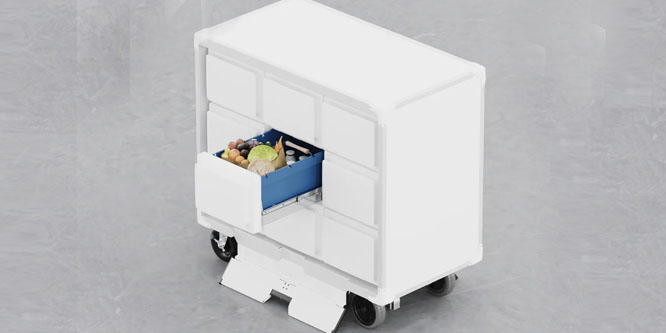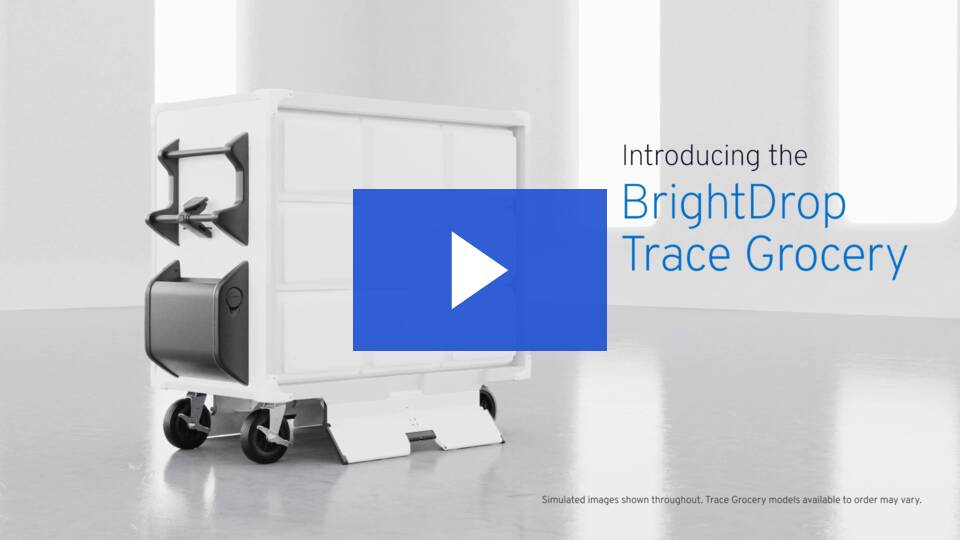
Image: BrightDrop Trace
Will electronic carts help Kroger fulfill curbside pickup orders more quickly?
Kroger is introducing a temperature-controlled electronic cart to speed up its curbside fulfillment.
The cart, called the BrightDrop Trace Grocery cart, was originally piloted in Kroger stores in Lexington and Versailles, KY, and is marked for a broader rollout since the pilot yielded a noticeable improvement in both customer and associate experience, according to the Detroit News.
The cart is fitted with nine secure, temperature controlled drawers in which employees can stock grocery orders before wheeling the cart to the curb. It is mechanized to allow an employee to easily pull 350 pounds of groceries at a comfortable walking pace. The next wave of the rollout will be limited, but the companies expect wide-scale availability of the cart by 2024.
Curbside pickup experienced an unprecedented spike in adoption at the beginning of the novel coronavirus pandemic as government regulations limited in-store shopping and concerns about potentially contracting COVID-19 kept shoppers out of stores.
BrightDrop Trace Grocery | Electric Propelled Grocery Cart
The popularity of curbside pickup has created challenges for retailers that have had to account for the cost of the investment in added labor and technology as well as the loss of impulse purchases, as a recent Washington Post article explains.
Sam’s Club, for instance, added a $4 surcharge for those using curbside pickup without a Sam’s Club Plus premium membership. Experts worry such surcharges in mainstream grocery, however, could push customers to competitors, especially since customers sometimes use curbside as a way to avoid delivery charges with services like Instacart.
Speeding up curbside does appear to speak to what customers are looking for. Back in late 2020, a Rakuten survey found that a great majority of customers (78 percent) considered having their order ready when they arrived at pickup to be the most important part of the curbside pickup experience.
The new cart at Kroger is not the only way retailers have been using technology to speed up the curbside pickup process.
Panera Bread, for example, has begun using GPS technology to alert store staff that curbside customers are nearing the store, according to a National Retail Federation (NRF) blog.
- GM’s BrightDrop electric cart will appear in Kroger stores for grocery pickup – Detroit News
- Curbside pickup is here to stay, and retailers are going all-in – The Washington Post
- Has COVID-19 revealed pickup pain points? – RetailWire
- 5 ways retailers are innovating curbside pickup – National Retail Federation
Discussion Questions
DISCUSSION QUESTIONS: What do you see as the biggest challenges that retailers face with curbside pickup and how can technology address these? Do you think the electronic cart technology addressed in the article will improve the curbside pickup experience for customers and associates?



For the most part, curbside pickup remains a hit or miss experience, depending upon the retailer. New technology like the electronic cart described does appear to offer a better way to do curbside, but there’s a significant cost to acquiring and maintaining this technology. Balancing off the cost of this versus the benefit to employees and customers will be the big question.
While I am a proponent of tech-enabled retail, I think electronic carts would be a big mistake. It turns out that 86 percent of BOPIS customers make additional purchases when picking up. Retailers should design the pickup process to encourage additional purchases. Electronic carts would seem to create a barrier to that by encouraging a “hit and run” pickup experience, as opposed to a concierge-like human experience.
Seems very odd to me, this test. Are the people that do this THAT bad at it? Or that expensive? I think what’s expensive is how often these things’ll screw up and customers will just go to a competitor. Technology for technology’s sake or for replacing labor when you don’t need to is not a good idea.
The biggest challenge for retailers with curbside delivery is how to minimize labor time and costs. While the temperature controlled and easy to pull features are nice, this cart doesn’t appear to reduce labor costs. It seems like temperature controlled lockers that could be loaded by staff from inside the store and accessed by customers outside the store might be a better alternative. That way, there would be less transport of goods by the store staff and customers could access their goods without any assistance.
The challenges of curbside pick-up begin with traffic flow and easy in-and-out parking. More challenges emerge in the accuracy of the picking and availability. The electronic cart may serve to supplant human labor and is probably less prone to delivery errors (the right station, the right customer). However electronic carts appear to be a costly device that cannot take more than two years to return the investment because by then, we will have a new concept being born.
The biggest challenge is not a better cart – several retailers have a similar cart that stores customers’ orders. The issue is the amount of order pickers on the floor – all at the same time. While I love evolving technology, no one has addressed that issue.
Location-sharing and/or beacons or RFID readers make it easier on the customer and the retailers to make just-in-time BOPIS possible. The loss of impulse shopping could be replaced by in-app purchases, maybe between order and pickup times. This would need to be done in an extremely non-pushy way, though.
On the back end, I believe MFC robotic pick and pack is the wave of the future. Maybe a hub and spoke model where one MFC at the hub services multiple stores is a hybrid that could work with this electronic cart solution. The key win for this very cool cart is the ability to have refrigerated/frozen and dry goods combo orders converge for pickup at the right time. Finding labor is the biggest challenge facing retailers today, but this technology can help address the shortcoming such as manual pick, pack and roll (discussed in this article) to a certain extent.
This is still too novel of a technology and a customer experience to really define what it means, if anything. A few test stores is one thing, but what about the additional sales that customers are exposed to (like pharmacy purchases or fresh goods/impulse items)? There are still many opportunities that grocery stores were designed to offer that using this type of technology limits.
One piece that you have to keep in mind is that grocery stores and cold storage are not designed for BOPIS or for curbside. Cold storage is in the back of the store, and unless you’ve flat-out remodeled the store to put more cold storage in the front, then either you’re sending employees on an expedition to fulfill these orders (which definitely wastes time and money), or you need something that brings cold storage closer to the front. I say this having watched my daughter work for a grocer/GM retailer not to be named – the one job she hated most of all was “Flex” – online orders/curbside pickup because she could literally end up walking 5-6 miles on a 4-hour shift. Why? Because of cold storage. And Flex had a timer countdown that impacted her performance – “If I wanted to be treated like that, I would work for Amazon.”
Throwing technology at a problem is rarely the best solution. In this case it adds complexity and cost to a simple but tedious process. Spending more on training might be a better investment.
The electric cart is nice to talk about, but it takes the eye off the ball for fixing BOPIS. BOPIS needs an entirely new reimagination. Today’s system grew out of the pandemic. That was an excellent intermediate fix. But if BOPIS is going to be efficient for the retailer and the shopper, it must be designed on a blank sheet of paper without the legacy of Rube Goldberg-style systems.
Another technology to help the curbside pickup experience. I’m not sure if it will work or not, but I love that companies continue to innovate and try new ideas. One day we’ll see one of these become the standard. Will this be the one? If not, we’ll find another way.
While the electronic cart has some noted advantages, the last mile is still replete with logistics and profitability challenges. If BOPIS is to be the preferred shopping method, we need to design the selection and delivery process accordingly. In the long run, mini fulfillment and Ocado-type 1000 robot fulfillment centers, which Kroger is pioneering, may move the interfering selection process from the store to the fulfillment center.
Despite the coolness and ease of use GM’s EV unit, BrightDrop, has introduced to the market with the carts, the market is murky. At a higher price of $5k per cart, Kroger, the largest grocery in the US will drive only a few $MM in sales across all their stores. The market size just seem to be small, especially for curbside which is still a small percent of ecommerce sales which is a minor percent of retail sales. A slightly faster experience and less backbreaking by associates (who would be fine with a $200 cart) isn’t enough justification for using the carts. I’d wait to see if there’s anything revolutionary such as automated order picking with the associate or something else that’s missing.
Curbside pick-up orders were not kept in a temperature-controlled environment which often deteriorated their quality. However, Kroger’s latest carts have the built-in feature to modulate the temperature. The fact that now the product’s quality will be preserved is what matters most. Therefore, I believe these carts would definitely help in enhancing customer experience. The only question that still remains unanswered is: Do the associated benefits outweigh the financial commitment required to incorporate this technology?